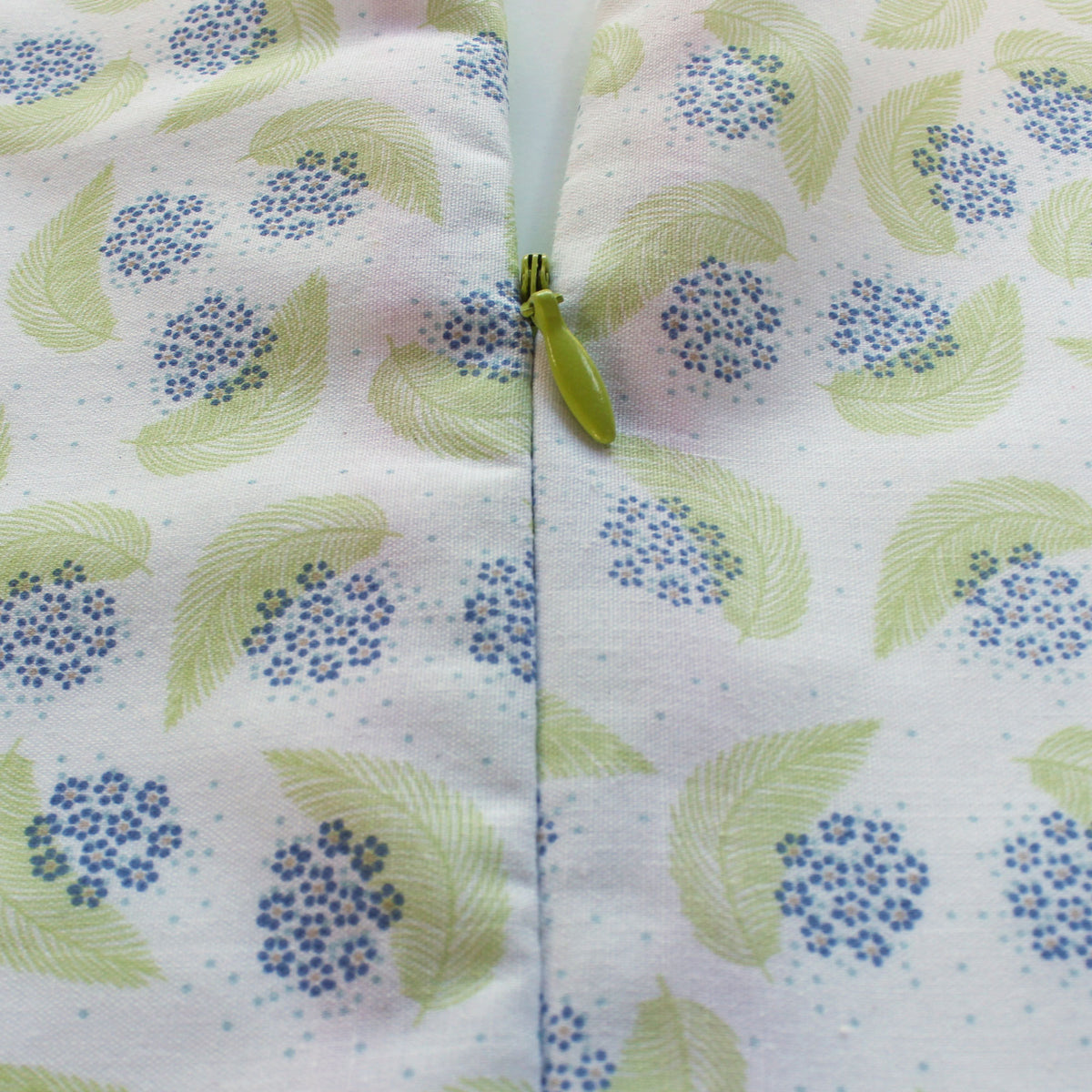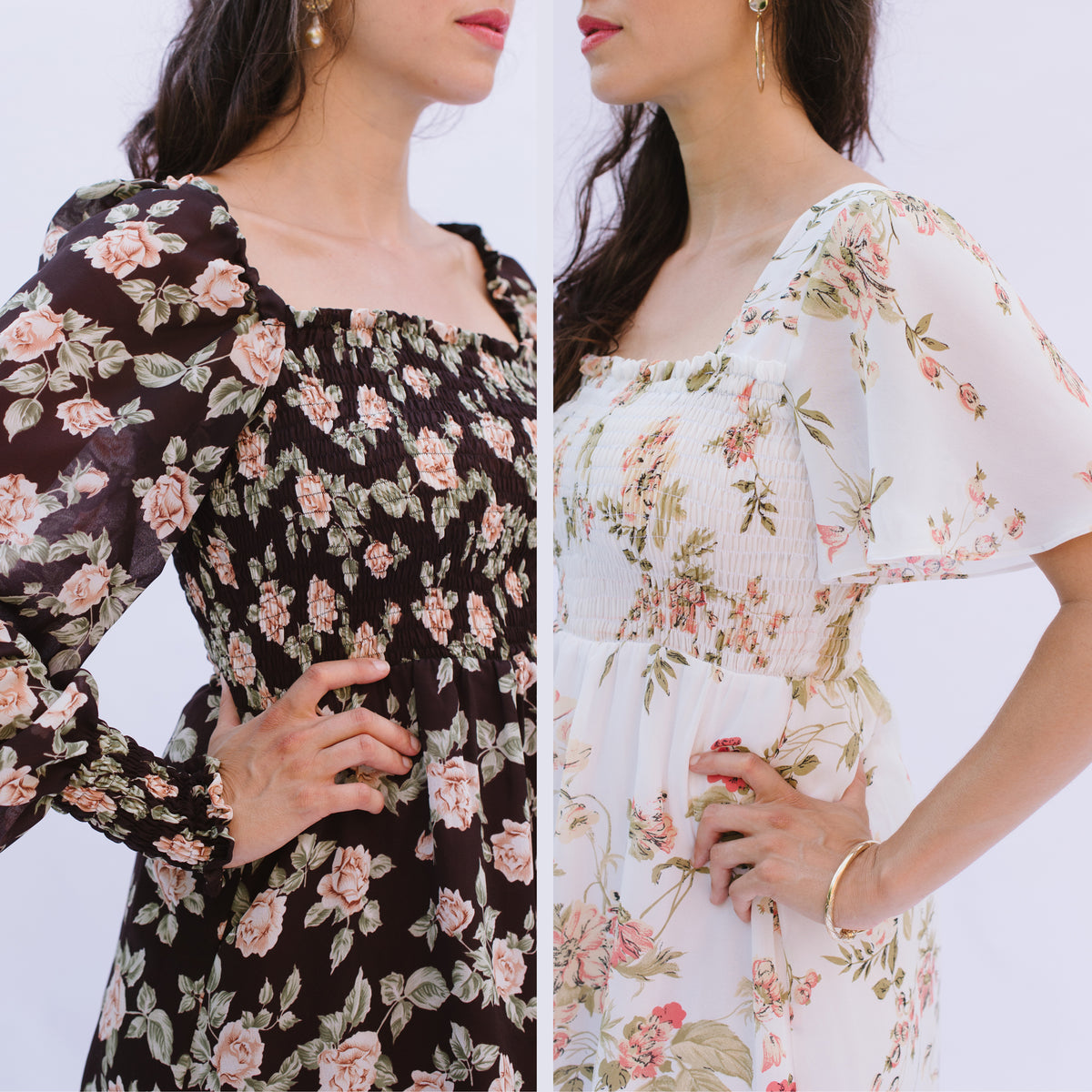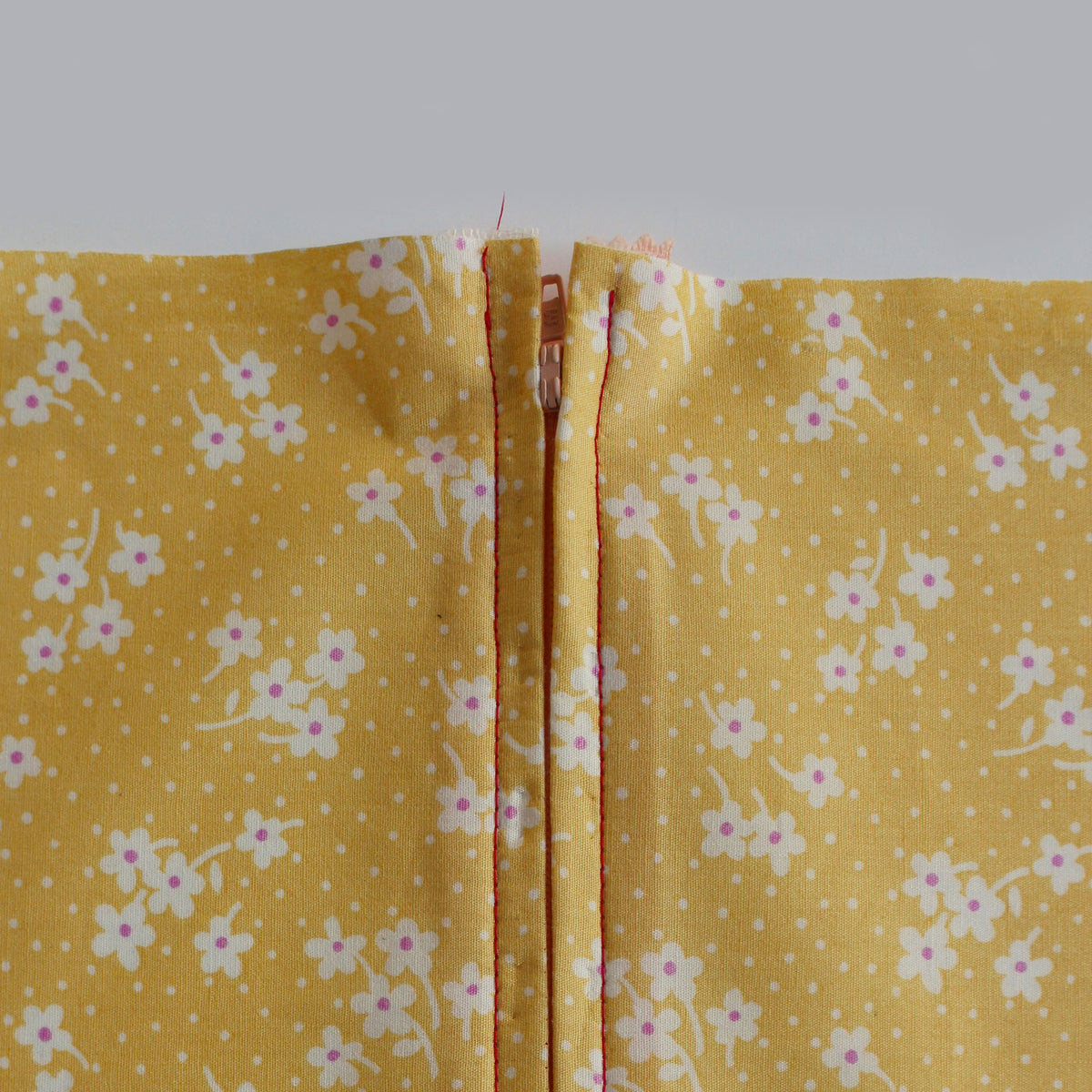Welcome to day 2 of the Jacke Sewalong. We've got a really juicy post for you! Today we will be selecting our size, determining if adjustments are needed and tracing the pattern. We'll guide you through three basic fit tutorials: full and small bust adjustments, grading between sizes and length adjustments for the Jackie pattern.
If you're new to this series and would like to follow this sewalong, sign up here!
TAKE YOUR MEASUREMENTS:
When taking your measurements, make sure the tape is parallel to the floor and snug but not tight around your body. Record the following measurements:
High Bust: A circumference measurement with the tape placed below your shoulder blades in the back and above your bust in front.
This measurement is used to determine if a bust adjustment is needed.
Bust: Around the fullest part of your bust.
Waist: Around your natural waist.
Hips: Around the fullest part of your hips.
Back neck to waist: From the back neck bone to natural waist.
Finding your Size / NECESSARY ADJUSTMENTS
Check all that apply...
You are one size throughout if your bust, waist and hip measurement all fall under one size, use that size to cut or trace your pattern.
You will need a bust adjustment if when you calculate the different between your high and full bust measurements, you get a result less than or greater than 2" (5 cm).
A result less than 2" (5 cm) means that you need a small bust adjustment. A result greater than 2" means you need a full bust adjustment. Important: When selecting your bust size, use your high bust measurement. We will make a bust adjustment to accommodate your full bust measurement. More on this in the bust adjustment tutorial.
Grade Between Sizes if your bust, waist and hip measurements fall between multiple sizes. Follow the tutorial for this adjustment below. If you are cutting your pattern out directly, make your adjustments prior to cutting the pattern. If you are tracing your pattern and need to make size grade adjustments, you can make the adjustments as you trace the pieces.
Length Adjustment: On the size chart, compare your personal back length measurement to the back length measurement that corresponds with your selected bust size. Length adjustments will be required if these two measurements differ by more than +/- 1/4" (.5 cm). You may also choose to make a length adjustment to the skirt. Follow the tutorial on lengthening/shortening below. Lengthening/shortening adjustments will be made after the pattern is traced.
Note on making a muslin:
For the best guarantee to be happy with the fit of your garment. It's wise to sew up a muslin. This should be done once you have made any necessary adjustments and traced out your pattern. Remember, a muslin is just a quick whipped up version of the garment to test for fit in the important areas of the garment. Since Jackie is full at the hip, we will only need to make a muslin for the bodice portion of the dress. I'd also suggest making a short version of the sleeve to test for fit along the arm. This way, you'll be able to save on fabric. You also won't have to worry about sewing the facings in. While this will change the structure of the neckline and center back of the dress in the final dress, you are simply checking the fit of the garment. You can make changes to your pattern based on your muslin's fit.
Tracing your pattern:
You will want to trace your pattern from your assembled PDF. If you are grading between sizes, you will make the necessary adjustments to the pattern as you trace. If you are making bust or length adjustments, you will first trace and then make your adjustments.
When you are ready to trace your pattern, lay your tracing paper over your assembled PDF pattern. Use weights to hold the paper in place. You can use the largest washers, which you can find at the hardware store or soup cans work well, too! Use a sharp pencil so your lines are accurate. Use your clear drafting ruler and if you need a hand with drawing curved lines, use a set of drafting curves for line accuracy. Make sure to transfer all pattern symbols, notches, grainlines and written annotations to your traced pattern. Trace the lines that are relevant to your selected version.
Tracing Supplies:

- Clear Drafting Ruler: For use when tracing your pattern grainlines and other straight edges.
- Paper Scissors: For cutting out your pattern once it has been traced.
- Eraser: To correct mistakes
- Pencil: Make sure it is sharp. I like to use a mechanical pencil with .5 HB led.
- Tracing Paper: For tracing your pattern pieces. Available at most art stores.
GRADING BETWEEN SIZES
We aren't always one size throughout our body. If you find that your measurements fall under more than one size, you may choose to grade between sizes. Since the skirt has a lot of wearing ease at the hip, it will still be safe to use the size chosen for our waist along the hip area. That being said, we can blend between our bust and waist sizes.
Note: Bust and length adjustments will be made after the pattern has been traced.
- Begin by tracing your bust size, blend smoothly to the waist size and maintain that size throughout the skirt.
- The pieces that you will need this adjustment are A (Dress Front, B (Front Side), E (Back Upper Center) and G (Back Side).
- For the following pieces, cut or trace based on your bust size: Pieces D (Back Facing), H (Front Facing), I (Sleeve), J (Armhole Facing), K (Back Fusing)
- For Piece F (Back Lower Center), cut or trace based on your waist measurement.
- The diagrams below will guide you through these adjustments for pieces A, B, E and G. An example is given for blending from bust size 8 to waist size 12, and the second example for bust size 8 to waist size 4.

Adjustments required for piece A based on the example.

Adjustments required for piece B based on the example.

Adjustments required for piece E based on the example.

Adjustments required for piece G based on the example.
Bust Adjustments:
Jackie is designed for a B-cup, therefore if you have a larger or smaller cup size, it's best to make a bust adjustment to your pattern. This adjustment will increase or decrease the width of fabric over the bust area, giving you a better fitting garment.
Just to review what we've talked about so far:
- You have determined if there is a difference between your high bust full bust and measurements that are greater or less than 2" (5 cm).
- If the difference is less that 2", you will need a small bust adjustment
- If the difference is greater that 2", you will need a full bust adjustment.
- You have selected your bust size based on your high bust measurement.
I want to talk about that last point for a sec, because you may be scratching your head as to why you haven't chosen your bust size based on your full bust measurement. In the event that you need a bust adjustment, selecting your bust size based on your high bust measurement ensures that the garment will fit you in the neckline and shoulder area. If you had selected your size based on your full bust measurement, given that you aren't a B-cup, it would mean that quite likely the area above the bust will be ill-fitting. The bust adjustment will increase or decrease width across the full bust so that you have to right cup size for your ladies.
To determine how much to adjust your pattern by, note the difference between your two bust measurements.
We will divide the difference by 2. We do this because we are working with half of the pattern.
We will then divide this amount in half again because we want to split the total adjustment amount across the two bust seams.
FBA Example:
Imperial: Full bust is 40", high bust is 37"
40 - 37 = 3" / 2 = 1.5"
1.5 / 2 = .75"
Metric: Full bust is 101.5 cm, high bust is 94 cm
101.5 - 94 = 7.5 cm / 2 = 3.75 cm
3.75 / 2 = 2 cm (rounded up)
Therefore we will add 3/4" (2 cm) to the bust of both pieces A and B.
SBA Example:
Imperial: Full bust is 37", high bust is 36"
37 - 36 = 1" / 2 = .5"
.5" / 2 = 1/4"
Metric: Full bust is 94 cm, High bust is 91.5 cm
94 - 91.5 = 2.5 cm / 2 = 1.25 cm
1.25 / 2 = .6 cm (rounded)
Therefore we will need to decrease the bust of both A and B pieces by 1/4" (.6 cm).
Gather your supplies:
- Pattern pieces A (Front Center) and B (Front Side).
- Scissors
- Tape
- Scrap paper (FBA)
- Pencil
- Ruler and curves
I'll start off with general instructions for both adjustments and the I'll break away with specifics for either adjustment....
Step 1: With a clear drafting ruler, draw your stitch line along the bust seam edges of Piece A and B. The seam allowance is 1/4" (.6 cm).

Step 2:
On both pieces, mark the notch that is placed at the fullest part of the bust. I've marked it here in red. This will be the Bust Point Notch.
We will now mark "hinge points" for our adjustment. These are indicated by black dots in the image below.
The first hinge will be marked along the stitch line, in between the two indicated notches at the top of the pattern pieces.
The second hinge will be marked near the lengthen/shorten the line, along the stitch line.

Step 3: On both of the pattern pieces, draw a straight line alongside the red bust point notch. This will be our Bust Line

Step 5: Clip into the seam allowance at the hinges and at the bust point notch. Cut to the stitch line.

Then, cut along the stitch line, beginning and ending the cutting at the hinges. You have now removed the seam allowance pieces.

Cut a very narrow sliver of tape and attach the seam allowance pieces to the body of the pattern at the "hinge" points. The tape will act as the actual hinge for the seam allowance pieces.

The seam allowance pieces will remain separate at the bust point notch.

At this point, I'll break up the tutorial into FBA and SBA. I'll start with the FBA; so if you're doing a SBA, just jump down.
Full Bust Adjustment
Tape the pattern pieces to your scrap paper. Do not secure the seam allowance pieces when taping the pattern.

Along the bust line, mark a point out from the pattern body by your adjustment amount. (e.g. 3/4", 2cm).

Make the same mark for piece B.

Swing your seam allowance strips out so that the inner edge of the strip aligns with the adjustment mark.

Tape the seam allowance pieces in place.

Repeat the steps for piece A.

With a curved ruler, adjust the pattern at the broken bust point edge.

Re-mark your bust point notches by drawing a new notch in the middle of the original notch. Make sure the depth of this notch is less than 1/4".

Trim the excess scrap paper and your adjustment is complete!

Small Bust Adjustment
Along the bust line that you have marked on the body of the pattern, mark a point in from the pattern edge by your adjustment amount. (e.g. 1/2", .6 cm).

Swing your seam allowance strips inwards onto the body so that the inner edge of the seam allowance strips align with the adjustment mark. Tape the seam allowance pieces in place.

You may need to use a broad curve here to smoothen out the adjusted edges.

Re-mark the bust line notch by positioning it in line with the original notch. Make sure the depth of the notch is less that 1/4" (.6 cm).

Trim the excess paper from your adjusted pattern and you're ready to go!

LENGTHENING AND SHORTENING
For length adjustments, we take into account our height. We also need to consider our body's proportions. We may have a short torso and long legs, or short legs and a long torso. For this reason, we have to ability to break up these adjustments between our upper and lower body.
ADJUSTING THE BODICE LENGTH:
We will compare our personal back length measurement to the back length measurement that corresponds with our bust size. If the difference is greater than +/- 1/4" (.6 cm), go ahead with a length adjustment for the upper portion of the dress.
Example 1 / Lengthening:
My bust size is 8, so the back length from the size chart is 15 3/8" (39 cm). My personal back length measurement is 14 3/4" (37.5 cm).
The difference is -5/8" (-1.6 cm).
I'll want to decrease the upper portion of the pattern pieces by 5/8" (1.6 cm).
Example 2 / Shortening:
My bust size is 8, so the back length from the size chart is 15 3/8" (39 cm). My personal back length measurement is 16" (40.5 cm).
The difference is 5/8" (1.6 cm).
I'll want to decrease the upper portion of the pattern pieces by 5/8" (1.6 cm).
ADJUSTING THE SKIRT AND LENGTH:
This pattern is for a height range of 5' 6"-5' 9" (168-175 cm).
Finished skirt lengths for either version are as follows:
Version 1: hemline ending just below mid-calf, approximately 32 1/2" (82.5 cm) down from the natural waist.
Version 2: hemline ending just below the knee, approximately 261/2" (67.3 cm) down from the natural waist.
Skirt length adjustments can be made based on preference on where you want the hemline to fall.
One thing to note is that the length given for the skirt length is measured from a flat paper pattern. Once the skirt is made with knit fabric, the length will likely be somewhat longer as knit stretches.
Determine the amount to adjust your pattern pieces by comparing your desired length measurement (measure down from your natural waist) to the length for your version. Take note of the difference between your desired length and your version’s length. This difference will determine how much to lengthen or shorten the pattern pieces.
NOTES BEFORE YOU BEGIN:
The exercises below demonstrate the upper body adjustment. Use the same method for adjusting the skirt length.
Alternatively, to adjust the skirt you can choose to trace a new hemline higher or lower than the existing hemline. The one caveat with lengthening this way is that if you extend the hem too far, it may not fit onto the width of your fabric and therefore you will have to lengthen by the method provided.
In the diagrams below, the adjustment is demonstrated on piece G, but these same adjustments will also need to be made to pieces A, B, D, E, F, G, and K.
LENGTHENING:
- Cut the pattern along the lengthen/shorten line (I cut along the lower line). Tape the upper portion of the pattern to a piece of paper.

- On this piece of paper, draw a line parallel the lengthen/shorten line by the amount to lengthen (in our example, 5/8" (1.6 cm).
- Extend the grainline down onto the new piece of paper. For pieces A and F, extend the center front/back line.

- Tape the lower portion of the pattern to the new lengthened line and align the grainline or center front/back line.
- Re-shape the side edges of the pattern that have been affected by the adjustment.

SHORTENING:
Steps:
- Measure down from the lengthen/shorten line by the amount to be shortened. Draw a line at this measurement, parallel to the lengthen/shorten line (I measure down from the lower line).

- Fold the pattern along this line and match it to the lower lengthen/shorten line.

- Tape the pattern in place.
- Make sure the grainline is aligned. For pieces A and F, align the center front/back edges of the pattern pieces.
- Re-shape the side edges of the pattern that have been affected by the adjustment. Paper is placed behind the pattern in case patching is required.

Next post: You will learn how to prepare and cut out your knit fabric.
YOU MAY ALSO LIKE:







